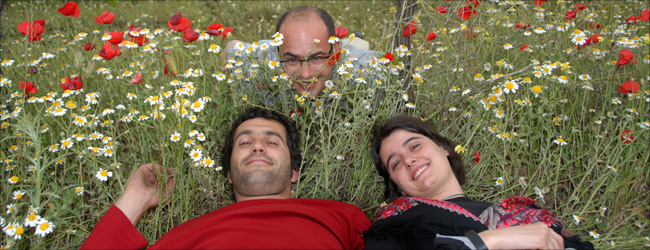We are sorry, this page has not been translated yet.
Azul y Garanza

Rejoice mischievously about the flourishing diversity of species on Azul y Garanza: The winemaking couple, Daniel Sánchez and María Barrena Belzunegui, and Delinat wine expert David Rodriguez (back).
“Azul y Garanza” means “blue and crimson”. An unusual, suggestive name for a vineyard. But the term does not come from the world of fantasy. It purely and simply describes the colour of the prestigious red wines of this estate. They come from very old Tempranillo vines that grow in the traditional bush form and are not irrigated. But Cabernet Sauvignon and Merlot also make their contribution.
Wine from the desert
When you visit the bodega of María Barrena Belzunegui and Daniel Sánchez in Carcastillo, you think you are travelling to the end of the world. It lies on the edge of the Bardenas Reales nature reserve. The desolate desert landscape with its bizarre rock formations forms the basis for the creativity of the two young oenologists. When the press increasingly reports signs of “dramatic change” and a “new avant-garde” in Navarra, they are usually referring to the innovative ideas of María and Dani. With their inclination for philosophy, theatre or gliding, the two are extending their personal horizons.
And the wines also benefit from the desert: Without irrigation, the yields are extremely low – but the wines become dense and concentrated, and in their aromas, they show subtle flowery elements but also mineral notes – works of art between opulent intensity and delicate elegance.

Incidentally, the dryness means that diseases like mildew are virtually unknown – which saves time and money on sprays. Consequently, the wines of Azul y Garanza offer excellent value.
How does this trick work? “It’s the influence of the desert. In the summer, it delivers temperature differences of over 20 °C between day and night. This results in grapes with thick skins. These in turn are a guarantee of plenty of fruit and structure with adequate natural acidity,” says Dani. But above all, there is a clear philosophy, a concept to be found behind each of their wines. That also applies to their magnificently fresh rosé Tempranillo with its seductive notes of raspberry.
Working on the vineyard of the future
María and Dani have already caused a stir with their wines but they are not satisfied with that. Together with Delinat, they too are working on the vineyard of the future.
They have acquired a few hectares at the edge of the nature reserve for their biodiversity project. All around the small plots, there is thick vegetation – natural biodiversity into which María and Dani have planted new vines. The use of vegetable carbon is also currently being tested on the new plots.




